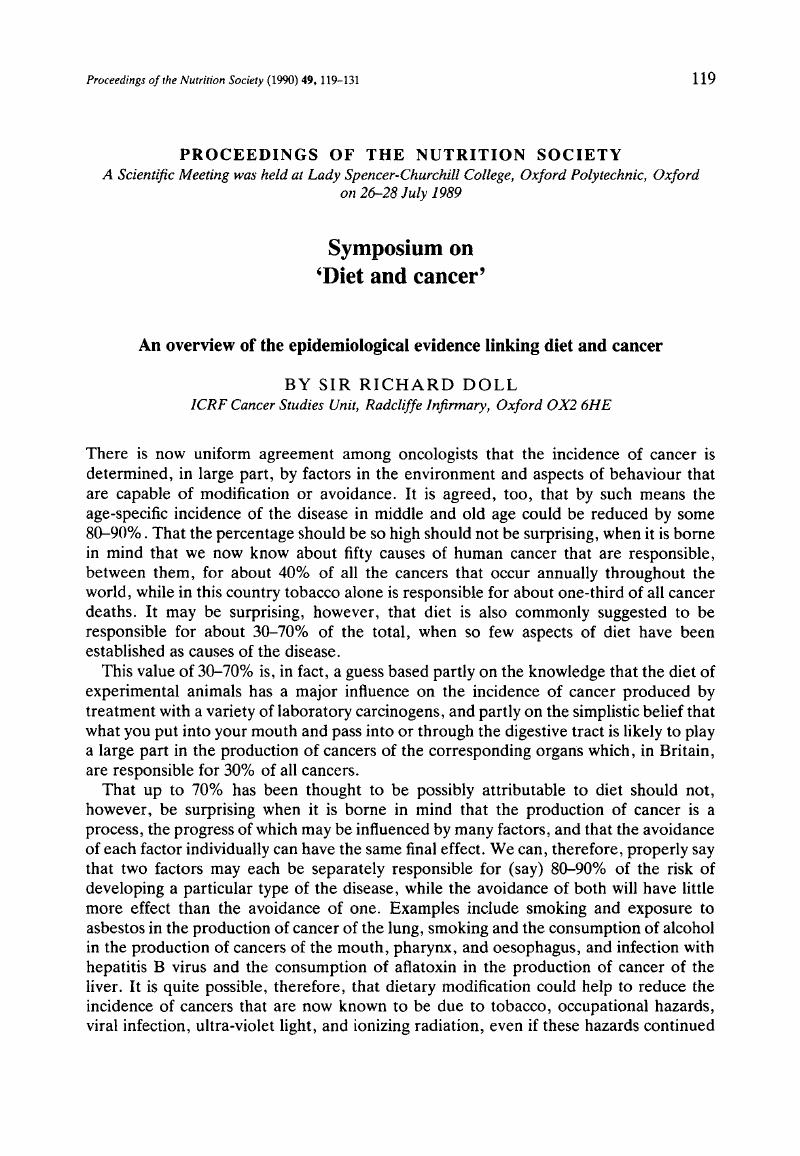Crossref Citations
This article has been cited by the following publications. This list is generated based on data provided by Crossref.
Henderson, Brian E.
Ross, Ronald K.
and
Pike, Malcolm C.
1991.
Toward the Primary Prevention of Cancer.
Science,
Vol. 254,
Issue. 5035,
p.
1131.
Madar, Zecharia
Timar, Bracha
Nyska, Abraham
and
Zusman, Igor
1993.
Effects of High‐fiber diets on pathological changes in DMH‐induced rat colon cancer.
Nutrition and Cancer,
Vol. 20,
Issue. 1,
p.
87.
Dragsted, Lars Ove
Strube, M.
and
Larsen, J. C.
1993.
Cancer‐Protective Factors in Fruits and Vegetables: Biochemical and Biological Background..
Pharmacology & Toxicology,
Vol. 72,
Issue. s1,
p.
116.
Berg, A.
Elias, P.
Feldheim, W.
Grossklaus, R.
Grüttner, R.
Keul, J.
Verspohl, E. J.
Wahrburg, U.
and
Wisker, E.
1995.
Hagers Handbuch der Pharmazeutischen Praxis.
p.
1.
ZUSMAN, IGOR
1995.
VARIABILITY OF NEOPLASTIC PARAMETERS IN COLON TUMOURS, AND ITS SIGNIFICANCE IN DIAGNOSTIC PRACTICE.
Biological Reviews,
Vol. 70,
Issue. 1,
p.
107.
van Loon, A. Jeanne M.
Burg, Johannes
Goldbohm, R. Alexandra
and
van den Brandt, Piet A.
1995.
Differences in Cancer Incidence and Mortality Among Socio-Economic Groups.
Scandinavian Journal of Social Medicine,
Vol. 23,
Issue. 2,
p.
110.
Enwonwu, C.O.
and
Meeks, V.I.
1995.
Bionutrition and Oral Cancer in Humans.
Critical Reviews in Oral Biology & Medicine,
Vol. 6,
Issue. 1,
p.
5.
Combs, Gerald F.
1996.
Should Intakes with Beneficial Actions, Often Requiring Supplementation, Be Considered for RDAs?.
The Journal of Nutrition,
Vol. 126,
Issue. ,
p.
2373S.
Wang, Hong
Cao, Guohua
and
Prior, Ronald L.
1996.
Total Antioxidant Capacity of Fruits.
Journal of Agricultural and Food Chemistry,
Vol. 44,
Issue. 3,
p.
701.
Cao, Guohua
Sofic, Emin
and
Prior, Ronald L.
1996.
Antioxidant Capacity of Tea and Common Vegetables.
Journal of Agricultural and Food Chemistry,
Vol. 44,
Issue. 11,
p.
3426.
WINTHER, J. F.
DREYER, L.
OVERVAD, K.
TJØNNELAND, A.
and
DE VERDIER, M. GERHARDSSON
1997.
Diet, obesity and low physical activity.
APMIS,
Vol. 105,
Issue. S76,
p.
100.
Wang, Hong
Cao, Guohua
and
Prior, Ronald L.
1997.
Oxygen Radical Absorbing Capacity of Anthocyanins.
Journal of Agricultural and Food Chemistry,
Vol. 45,
Issue. 2,
p.
304.
Neault, Jean-F.
and
Tajmir-Riahi, H. A.
1998.
DNA−Chlorophyllin Interaction.
The Journal of Physical Chemistry B,
Vol. 102,
Issue. 9,
p.
1610.
Cao, Guohua
Russell, Robert M.
Lischner, Neal
and
Prior, Ronald L.
1998.
Serum Antioxidant Capacity Is Increased by Consumption of Strawberries, Spinach, Red Wine or Vitamin C in Elderly Women.
The Journal of Nutrition,
Vol. 128,
Issue. 12,
p.
2383.
Joseph, James A.
Denisova, Natalie
Fisher, Derek
Shukitt-Hale, Barbara
Bickford, Paula
Prior, Ronald
and
Cao, Giohua
1998.
AGE-RELATED NEURODEGENERATION AND OXIDATIVE STRESS.
Neurologic Clinics,
Vol. 16,
Issue. 3,
p.
747.
Prasad, Kedar N.
Cole, William
and
Hovland, Peter
1998.
Cancer prevention studies: Past, present, and future directions.
Nutrition,
Vol. 14,
Issue. 2,
p.
197.
Joseph, J. A.
Shukitt-Hale, B.
Denisova, N. A.
Prior, R. L.
Cao, G.
Martin, A.
Taglialatela, G.
and
Bickford, P. C.
1998.
Long-Term Dietary Strawberry, Spinach, or Vitamin E Supplementation Retards the Onset of Age-Related Neuronal Signal-Transduction and Cognitive Behavioral Deficits.
The Journal of Neuroscience,
Vol. 18,
Issue. 19,
p.
8047.
Bałasińska, Bożena
and
Troszyńska, Agnieszka
1998.
Total Antioxidative Activity of Evening Primrose (Oenothera paradoxa) Cake Extract Measured in Vitro by Liposome Model and Murine L1210 Cells.
Journal of Agricultural and Food Chemistry,
Vol. 46,
Issue. 9,
p.
3558.
Neault, J.F.
and
Tajmir-Riahi, H.A.
1999.
Structural Analysis of DNA-Chlorophyll Complexes by Fourier Transform Infrared Difference Spectroscopy.
Biophysical Journal,
Vol. 76,
Issue. 4,
p.
2177.
Williamson, Sophia L.H.
Kartheuser, Alex
Coaker, Julie
Kooshkghazi, Mahshid Dehghan
Fodde, Riccardo
Burn, John
and
Mathers, John C.
1999.
Intestinal tumorigenesis in the Apc1638N mouse treated with aspirin and resistant starch for up to 5 months.
Carcinogenesis,
Vol. 20,
Issue. 5,
p.
805.



